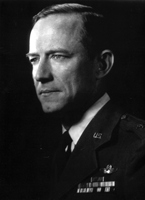Brig Gen Noel F. Parrish
was enshrined in 2001
was enshrined in 2001

Gen Noel Parrish, a native of Lexington, had a dramatic impact on the U.S. Armed Forces and our entire nation. He was the white commanding officer of Tuskegee Army Air Field, Alabama, during World War II. Gen Parrish graduated from Rice University at age 18 and, in 1930, enlisted in the Army and joined a horse cavalry unit. A year later, he began aviation cadet training and served as a flight instructor before being assigned to Tuskegee in 1941 (just two days before the attack on Pearl Harbor).
At Tuskegee, he was responsible for the first program to train black pilots for combat duty. At that time the armed forces were segregated and blacks were routinely denied important combat assignments. As the white commander of this predominantly black organization, he managed the program in the face of harsh opposition. But, thanks to Gen Parrish's dynamic leadership, the program was a huge success. Surviving members of the 996 African-Americans who earned wings at Tuskegee attest to the fact that Gen Parrish ran a rigorous and demanding program with a high attrition rate.
The cadets who graduated were among the best pilots in the Army Air Corps. The 450 pilots who fought the Luftwaffe in North Africa, Sicily and Europe, as members of the 99th Fighter Squadron and later the 332nd Fighter Group (the famous "Red Tails"), never lost a bomber they were escorting on over 200 missions to targets all over Nazi-held Europe. Flying their propeller driven P-51s on a 1,500-mile mission to Berlin in May 1945, three of the "Red Tails" shot down one of the new German jet fighters, the ME-262. All told, Tuskegee Airmen destroyed 261 Nazi aircraft. Their combat decorations include 150 Distinguished Flying Crosses, 744 Air Medals and a Presidential Unit Citation. The many accomplishments of this distinguished group of aviators are directly attributable to the excellent training they received under Gen Parrish's leadership at Tuskegee.
After World War II, Gen Parrish attended the Air War College where he wrote a thesis on the integration of the U.S. Armed Forces. He then served as Assistant to Air Force Chief of Staff General Hoyt Vandenberg, specializing in issues regarding integration in the military. Following various assignments with NATO and Headquarters, USAF, he served for three years as Director of the Research Studies Institute at Maxwell Air Force Base, Alabama. He retired in 1964; his military decorations include the Legion of Merit and the Air Medal.
Gen Parrish died April 7, 1987. His unique legacy includes his role in the training of almost 1,000 African-American aviators and command of over 14,000 ground support personnel at Tuskegee. His leadership and determination led to the desegregation of the U.S. Armed Forces on July 26, 1948 when President Harry Truman signed Executive Order #9981.
